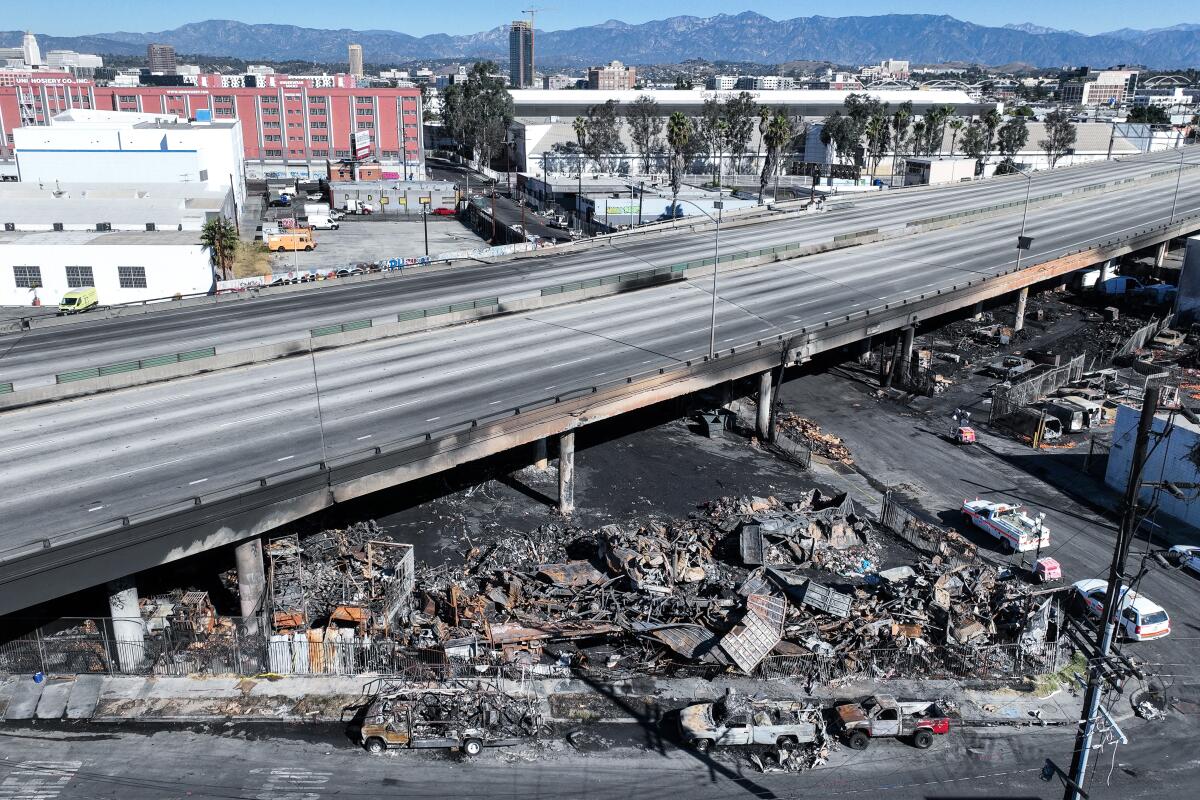In the fight against illegal cannabis, language complicates the conversation

- Share via
Good morning. It’s Monday, Nov. 13. Here’s what you need to know to start your day.
- In the fight against illegal cannabis, language complicates the conversation
- A fire has closed part of the 10 Freeway indefinitely
- Sandwiches and pastries shine at a cozy French window.
- And here’s today’s e-newspaper.
Sign up for Essential California
The most important California stories and recommendations in your inbox every morning.
You may occasionally receive promotional content from the Los Angeles Times.
When cartel doesn’t mean cartel
I’m Paige St. John, joining in from the investigative desk at The Times.
I’ve reported on the darker side of California cannabis since the state legalized recreational weed in 2016, and unleashed a boom in outlaw cannabis. We published our first investigation in 2017, examining what seemed an unsustainable explosion of illegal small farms run by Hmong growers in the high desert of Siskiyou County.
Cannabis experts said this community would wither, unable to compete with the newly legal market. They were wrong. Satellite imagery shows Siskiyou County now boasts the state’s greatest concentration of cannabis, all of it illegal.
From the start, rhetoric diverted frank discussion about the rapidly expanding billion-dollar criminal industry. Law enforcement, lacking resources to identify the leaders of these multi-state operations, reached for a familiar label: “cartel.” So, too, did frightened rural residents who found themselves surrounded by illegal greenhouses patrolled by men with guns. Such semantics denigrate the most vulnerable players in this California business, relegating them to the shadows, including a father and son who hoped to send money home and instead lost their lives.
In the criminal world, “cartel” is normally shorthand for Mexican drug syndicates, notoriously violent organizations that put dismembered bodies on public display, and terrify and torment entire towns.
But in Siskiyou County, the cartel was Hmong refugees arriving from Milwaukee. When Chinese growers from Sacramento moved into the valley, they, too, were “cartel.”
When reporting took me to the north coast, I encountered Bulgarian growers. They also were “cartel.” And throughout California, outlaw cannabis operations that used Mexican laborers were labeled “cartel,” even where landowners were white and the grow bosses unknown.
The sheriff of Tulare County in January instantly blamed the massacre of six people (including an infant in arms) on “the cartel,” due to the violence, then incrementally dialed back his language as it became known the Goshen massacre was a turf war between Central Valley gangs.
What I did not find were criminal cases that link California cannabis to the violent narco-trafficking cartels of Sinaloa or Michoacan. Rural police lack the ability to even investigate. Siskiyou County’s two-man narcotics squad spends a good deal of time bulldozing plants beside the two-man squad in Mendocino County. And in Trinity County. And in Humboldt County.
Yet “cartel cannabis” has become a trigger phrase to decry U.S. immigration policy.
Such language distorts a lot about California’s outlaw cannabis industry. For one, it obfuscates the homegrown nature of the state’s weed trade, shifting blame for its violence and pervasiveness to an evil external force.
And second, it discounts a very large victim class, its workers.
Cannabis is among the nation’s most labor-intensive crops, on par with strawberries. Laborers are low wage and transitory, moving from farm to farm, sleeping next to or sometimes in the greenhouses they tend. They are predominantly minority, drawn from immigrant communities and migrant labor pools. Wage theft is common. And their deaths are untracked.
I analyzed coroner records from the 10 counties willing to provide them, and found 44 cannabis farm deaths over a five-year period. Often, county officials removed identifying information needed to track down next of kin who could describe the lives and goals of these lost workers.
A rare exception was the family of Ulises Ayala, a Mexican shoe salesman who with his teenage son came north in search of work. The father and son wound up on a cannabis farm in Mendocino County, where they were shot, beheaded, and then incinerated on a pile of burning tires, with live chickens thrown into the pyre.
Their killer, a California weed farmer, said his victims were “cartel.” And he was certain no one would report their deaths.
Today’s top stories
Transportation
- A milelong section of the 10 Freeway in downtown Los Angeles that was damaged in a devastating fire over the weekend will remain closed indefinitely, posing major traffic challenges.
- Here’s what you need to know to avoid the mess on your commute.
- Gov. Gavin Newsom is mesmerized by the growth of driverless cars and he wants to keep the state the global leader in the development of autonomous technology. Other California Democrats, not so much.
Hollywood
- Hollywood political donations, sharply stymied by this year’s strikes, are expected to spike now that the Screen Actors Guild has reached a tentative deal with the studios.
- SAG-AFTRA’s national board of directors on Friday cleared the way for members to vote on the tentative contract.
War in the Middle East
- A halfway war pulses on Israel’s border with Lebanon. Will it escalate?
- After a 69-year-old man died at a Los Angeles protest, the lack of a resolution to the case — and lingering questions about exactly what happened to Paul Kessler — has hung over memorials and tributes.
- Two teachers at a public charter school were placed on leave over “lesson on the genocide in Palestine.”
- A Newport Beach student was suspended for remarks to another student, including “Free Palestine.”
Education
- Enrollment of international students rebounds from the pandemic plunge as California stays No. 1.
- The University of Southern California has cut ties with a controversial online education company that ballooned its social work school’s enrollment to the largest in the world but harmed the program’s finances and academic reputation.
Climate and Environment
- The first significant storm of the season in Southern California is expected to arrive midweek, bringing cooler temperatures and 1 to 2 inches of rain.
- Corporate growers’ carrots are soaking up water in this arid valley. Locals are fighting back.
- ‘We’re not going to quit’: Voices from a California community boycotting carrots.
- A massive former military hangar that burned in Tustin last week, closing schools over asbestos worries, reignited Saturday night.
More big stories
- A new trove of surveillance videos from inside the Los Angeles County jails offers a rare view of the culture of violence that has persisted behind bars.
- After years of secrecy, the Air Force’s B-21 Raider took its first flight Friday in Palmdale, giving plane enthusiasts, contractor employees and the public its first glimpse of the futuristic-looking bomber in air.
- After a 1-year-old’s death, a trove of investigative records released to The Times revealed a troubling history of allegations of child abuse and neglect stretching back more than a decade against his mother.
- Lynn Williams made history Saturday as she led Gotham FC to its first NWSL championship.
- Individuals who are skeptical of vaccines for themselves are also more likely to question the need or efficacy of getting shots for their four-legged companions, according to a recent study.
- Twenty-seven years after his death, Tupac could win his first Grammy thanks in part to a five-episode FX docuseries.
Get unlimited access to the Los Angeles Times. Subscribe here.
Commentary and opinions
- Frank Shyong: Once flush with Chinese tourism dollars, San Gabriel Valley searches for a new normal.
- Robin Abcarian: Censorship rears its ugly head at Santa Monica College, over a play about slavery.
- Opinion: Why Palestinian Americans believe Rep. Rashida Tlaib spoke the truth.
- Opinion: Kids have been used like guinea pigs on Big Tech’s platforms. How much harm will we tolerate?
- Editorial: Deputy deaths are a reminder that law enforcement can be lonely, traumatic work.
Today’s great reads
No fun in Acapulco: Smashed buildings, overturned boats and broken lives in wake of Hurricane Otis. Otis is the strongest storm on record to have ever battered Mexico’s Pacific Coast, scientists say. And it hit Acapulco head-on with sudden fury that left authorities, residents and tourists with little time to prepare as Otis plowed a broad swath of destruction.
How can we make this newsletter more useful? Send comments to essentialcalifornia@latimes.com.
For your downtime
Going out
- 🥐 Sandwiches and pastries shine at Maison Matho, a cozy French window near the 101 Freeway.
- 🍽 Looking for Black-owned restaurants in L.A.? The Times’ Jenn Harris found her new favorites here.
- 🐶 Take your best friend to play in the sand at these 31 dog-friendly beaches in L.A. and Orange counties.
Staying in
- 📺 The ASKN ladies from “The Golden Bachelor” talk love, loss and going topless in St. Maarten.
- 🦃 A spicy Thanksgiving? Pass the mala stuffing, with Fly by Jing founder Jing Gao.
- ✏️ Get our free daily crossword puzzle, sudoku, word search and arcade games.
And finally ... a great photo
Show us your favorite place in California! Send us photos you have taken of spots in California that are special — natural or human-made — and tell us why they’re important to you.
Today’s great photo is from Paul Yem for The Times’ Image Magazine. Yem is interested in the idea of “manufactured happiness” and sees it in the homes of suburban Los Angeles, which he describes as “candy-coated anti-depressants.” Read more about his perspective in this interview.
Have a great day, from the Essential California team
Paige St. John, reporter
Laura Blasey, assistant editor
Check our top stories, topics and the latest articles on latimes.com.
Sign up for Essential California
The most important California stories and recommendations in your inbox every morning.
You may occasionally receive promotional content from the Los Angeles Times.











